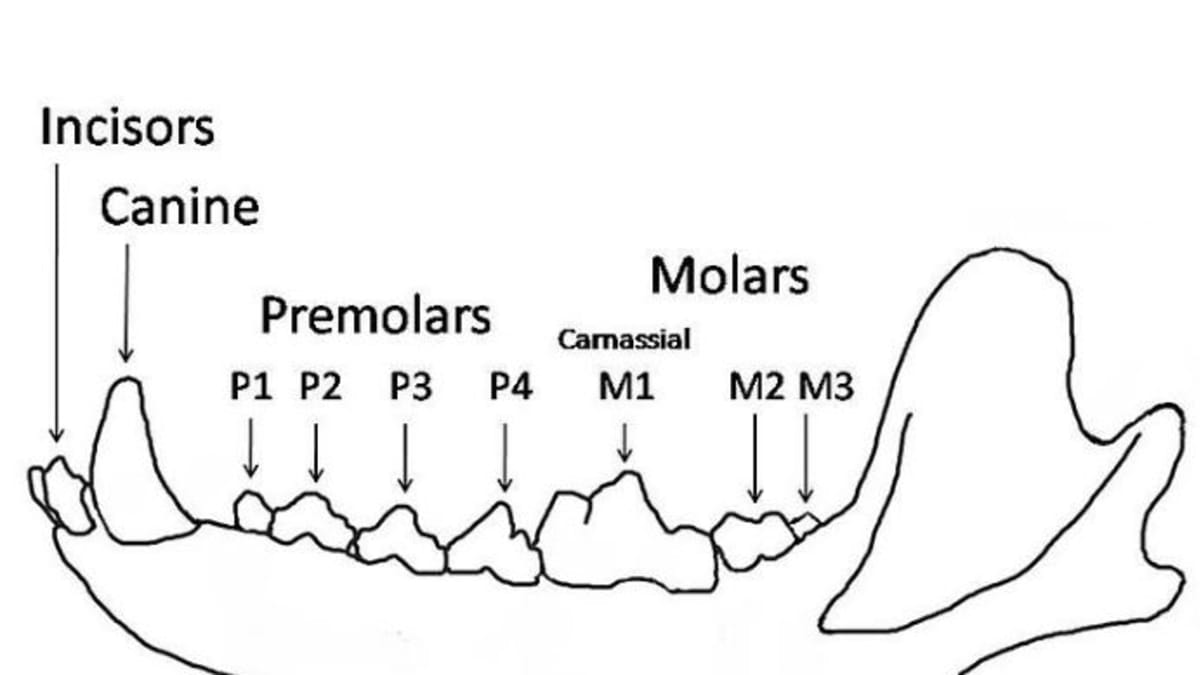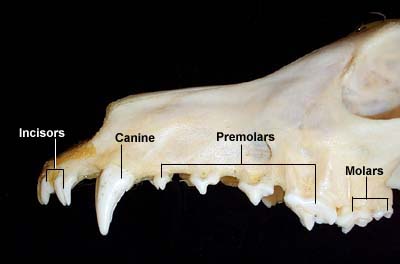
Canines are teeth which are situated on the left and right sides of incisors. The bad tooth was a premolar.

As adjectives the difference between canine and molar is that canine is of or pertaining to a dog or dogs while molar is of or relating to the molar teeth or to grinding or molar can be chemistry of relating to or being a solution containing one mole of solute per litre of solution.
Difference between dog premolar and molar. Moving on in the oral cavity the premolars are the frontal molars which are significantly slimmer than the neighboring molars because they are placed directly behind the canine teeth. The premolars normally have a chewing surface with two humps. The second lower premolar can also have three protrusions.
Regarding structure and function. The main distinctions between premolar and molar teeth are in their size and shape. While a molar has four cusps or points a premolar has only two.
Molars are also significantly larger than their bicuspid neighbors. At their simplest a pre-molar means it comes before the molar teeth in the dental arch. Another term is bi-cuspid because they usually appear to only have two cusps.
A molar typically has five cusps which means they are larger because they are made of more apparent components. The premolar teeth or bicuspids are transitional teeth located between the canine and molar teeth. In humans there are two premolars per quadrant in the permanent set of teeth making eight premolars total in the mouth.
As nouns the difference between premolar and canine is that premolar is a tooth situated in front of the molar teeth. Especially a tooth in humans with two cusps which is between the canines and the molars latin. Singular dens premolaris plural dentes premolares jump while canine is any member of caninae the only living subfamily of canidae.
Key Difference First vs Second Premolar Premolars are the teeth that are situated in between the canine and the molar. They are also known as the transitional teeth and mainly involved in the mastication of food. There are two types of premolars.
The mandibular premolar and maxillary premolar. In humans the premolars are further divided as first and second. Dogs have four molars 2 on each side in the upper jaw and six 3 on each side in the lower.
As nouns the difference between molar and premolar is that molar is a back tooth having a broad surface used for grinding ones food while premolar is a tooth situated in front of the molar teeth. Especially a tooth in humans with two cusps which is between the canines and the molars latin. Singular dens premolaris plural dentes premolares jump.
As adjectives the difference between canine and molar is that canine is of or pertaining to a dog or dogs while molar is of or relating to the molar teeth or to grinding or molar can be chemistry of relating to or being a solution containing one mole of solute per litre of solution. When used as nouns premolar means a tooth situated in front of the molar teeth whereas tooth means a hard calcareous structure present in the mouth. They sit next to incisors.
Canines are teeth which are situated on the left and right sides of incisors. Humans have four canines. Two on the upper side and two on the lower side of the jaw.
Canine has a sharp pointy surface for tearing food. Premolar has to sit next to the canine. Four premolars at the upper side and four premolars at the downside.
Premolar canines As nouns the difference between premolar and canines is that premolar is a tooth situated in front of the molar teeth. Especially a tooth in humans with two cusps which is between the canines and the molars latin. Singular dens premolaris plural dentes premolares jump while canines is.
Premolar plural premolars A tooth situated in front of the molar teeth. Especially a tooth in humans with two cusps which is between the canines and the molars Latin. Singular dens premolaris plural dentes premolares 1980 Anthony Burgess Earthly Powers.
He opened and let out a hogo of medicinal rum and beer. The bad tooth was a premolar. Maxillary molars are the molars in the upper jaw while mandibular molars are the molars in the lower jaw.
In an adult there are four types of teeth found in both maxilla and mandible namely. Incisors 8 canine 4 premolars 8 and molars 12. In this article we mainly focus on the difference between maxillary and mandibular molars.
Since the distal contact of second premolar is with the first molar the contact area is slightly larger in size when compared to the first premolar. Both the distal contact area and marginal ridge are located at a slightly more cervical level than on the distal of the first premolar. The first premolar displays sharper more prominent cusps with the buccal cusp being significantly larger than the palatal cusp.
The second premolar has more rounded shorter cusps that are similar in size. While a molar has four cusps or points a premolar has two to three. While premolars are larger and wider than your more narrow canine teeth and have a flat surface area molars are significantly larger than their bicuspid neighbors.
Both molars and premolars have pits and fissures between their cusps that can trap the food and bacteria that lead to cavities. First molar and the mesial surface of the third molar contacts the distal of the second molar. The third molar is the last tooth in the arch and its distal surface is not in contact with any other tooth.
Adult dentition with the Universal numbers for molars highlighted in red. Incisors Canine Canine Incisors Canine Canine Premolars. The maxillary and mandibular first molars were protracted a greater amount in the premolar group than in the second-molar group.
The lower lips in the premolar group were retracted a greater amount than in the second-molar group. The resulting facial profile after extraction of second-molars appears to be no different from that obtained after extraction of first premolars. GENERAL FEATURES OF PREMOLARS They are transitional teeth located between the canine and molar teeth.
Premolars are permanent teeth distal to the canines and successors to deciduous molars. There are two premolars per quadrant and are identified as first and second premolars. They are attached to the mandible which is the lower jaw.
They erupt at the age of 9 10 years. The key difference between the maxillary and mandibular canines is the location of the teeth. The maxillary canines are attached to the upper jaw whereas the mandibular canines are attached to the lower jaw.
The occlusal surface of the Molar consists of cusps which help in mastication of food or chewing. The molars also help in maintaining the vertical height of the oral cavity and also the face. The occlusion of the molar cusps is very important in determining proper occlusion of the oral cavity and it is important in Orthodontic treatment as well.
Evaluating the coefficient of determination no nonlinear model provided a better fit than the linear model. Thus the linear simple and multiple regression were chosen as the best prediction model. Next Pearsons linear regression analysis was performed in order to determine the correlation between canine diameters and premolar and molar diameters.